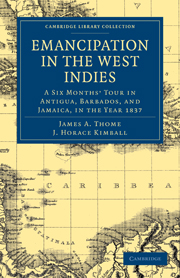 Emancipation in the West Indies
Emancipation in the West Indies ANTIGUA.–PART I
Published online by Cambridge University Press: 05 July 2011
Summary
CHAPTER I.
Antigua is about eighteen miles long and fifteen broad; the interior is low and undulating, the coast mountainous. From the heights on the coast the whole island may be seen at one view, and in a clear day the ocean may be seen entirely around the land, with the exception of a few miles of cliff in one quarter. The population of Antigua is about 37,000, of whom 30,000 are negroes–lately slaves,–4500 are free people of color, and 2500 are whites.
The cultivation of the island is principally in sugar, of which the average annual crop is 15000hogsheads. Antigua is one of the oldest colonies, and ranks high in importance and influence. Owing to the proportion of proprietors resident in the island, there is an accumulation of talent, intelligence and refinement, greater perhaps, than in any English colony, excepting Jamaica. Few in our country have an adequate conception of its rank and resources; consequently they undervalue the importance of the experiment of immediate emancipation now in progress there.
Our solicitude on entering the Island of Antigua will readily be imagined. Charged with a mission so nearly concerning the political and domestic institutions of the colony, we might well be doubtful as to the manner of our reception. We knew indeed that slavery was abolished, tha Antigua had rejected the apprenticeship, and adopted entire emancipation. We knew also, that the free system had more than realized the hopes of its advocates.
- Type
- Chapter
- Information
- Emancipation in the West IndiesA Six Months’ Tour in Antigua, Barbados, and Jamaica, in the Year 1837, pp. 15 - 93Publisher: Cambridge University PressPrint publication year: 2010First published in: 1839
